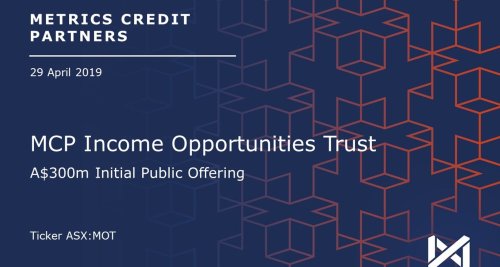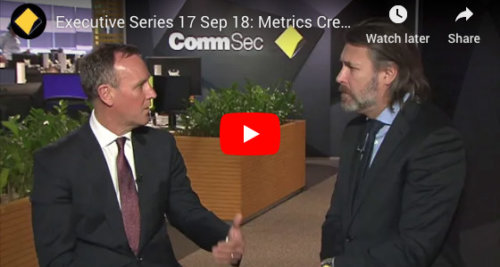Andrew Lockhart on corporate loans as an income alternative
In this Firstlinks interview with Graham Hand, Andrew Lockhart makes a case for corporate loans as an income alternative.
GH: Can you give us a short introduction to Metrics Credit?
AL: We launched our first fund in June 2013, starting with three partners, and the business now runs about $9 billion in assets under management with close to 80 employees. We directly originate loans to companies to support their activities to deliver good returns for our investment clients.
GH: Let’s start with the product most of our readers might know, the two listed trusts, MOT and MXT. There’s an ongoing debate about the relative merits of LICs, LITs and ETFs. Why do you believe the closed-end structure of a LIT is better for your asset class in the listed space than an open-ended Active ETF?
AL: Both can coexist but we want to create investment products that cater to individual investors’ risk, return and liquidity requirements. The attractiveness of the listed closed-end structure is that companies need to know that the lender has committed capital that will not be withdrawn in difficult market conditions.
Consider the context of a large corporate client with a revolving loan facility, which they can draw or repay under a funding facility, or a company that’s completing a property development project. They must know that when they submit the funding request, the lender has the capital and can provide the funding. So having that source of funding that is not subject to redemption risk gives our borrower clients confidence when they deal with Metrics. As a result, we gain access to better quality lending opportunities than we might otherwise.
GH: And while LICs and LITs have come in for a lot of criticism, in your asset class, it’s not easy to liquidate a corporate loan to fund a redemption in the same way as a fund holding an ASX 200 company.
AL: Exactly right. They are private loans so they can’t be bought and sold over an exchange. With an ETF, there is a market maker that has the ability to buy and sell the assets of the fund, creating liquidity for investors. In our asset class, other lenders that are sitting alongside us providing funding to companies are often banks, and there’s not a market maker that buys and sells loans to different companies to create liquidity in short periods of time.
The investor is able, hopefully, to achieve a premium return as we are lending for say three or five years. The margin and the fees to the company are higher than a short-term exposure. The investor receives a premium or pick up with the flexibility to buy or sell those units at short notice on the stock exchange on a daily basis if they wish.
GH: The credit you provide is corporate loans or private credit to unrated borrowers. What has been your default and loan loss experience over the years?
AL: Over the eight years since we established Metrics Credit, we’ve completed lending of close on $15 billion and in excess of 450 individual loan transactions. We have never delivered a loss to our investors. We’ve had four companies where we’ve had some form of restructuring or credit management associated with those loans. But in each case, we’ve been able to manage our investors’ exposure and exit from those loans without loss. Two of those four borrowers had a default but we worked through a process to ensure that our investor capital wasn’t at risk of loss. The part of the capital structure bearing the most risk of loss is equity, and so shareholders in those companies and those projects suffered a loss but we as a lender did not.
And that’s an important feature of where you sit in the capital structure, together with the benefits of corporate insolvency laws that protect the interests of a secured creditor. We’re always focused on the ways we can exit our exposure to ensure we can get our investors’ money back if we need to.
GH: The test is when you have a severe stress event. How did the portfolio perform in the depths of COVID, say in March 2020?
AL: Credit to the government and the regulators for the support they provided. If you had asked me in March last year, I thought we were facing rising unemployment, declining asset prices and defaults. But the combination of strong management responses, government packages and the Reserve Bank lowering interest rates and supporting liquidity all helped economic activity.
Obviously, for a lender, there’s no joy in seeing companies struggling. The government response facilitated the retention of employment and companies weathered the storm, but equally, companies raised equity capital. While that destroys value for existing shareholders, as it dilutes equity, fresh equity capital on the balance sheet reduces risk and gives the company liquidity.
We’ve seen similar events in other cycles as a lender. If credit quality or market conditions deteriorate, a lender can encourage a company to sell assets to repay debt, or maybe raise equity, while a lender is also conscious of preserving a going-concern value. Over the last year, we’ve maintained a strong discipline in lending to around 190 individual companies with income and capital stability for our investors.
GH: You regularly report the Net Asset Value (NAV) of your listed funds to the exchange. How do you come up with that number when none of your assets are listed?
AL: Investors need confidence in the NAV of our funds and the governance structure that oversees it. We have an independent RE (Responsible Entity) and a trustee across our funds who are responsible for the oversight of our activities. We also have an independent international accounting firm to test the market value and the portfolio monthly to determine whether there’s any risk of credit loss or impairment that would be a reduction to the value of the portfolio.
These are not traded loans so they’re generally held to maturity. Based on the credit quality of the borrower and the tenor of the loan, we can derive a market-based price. If there is a situation where a borrower might default or we are unlikely to recover the full value of our loan, then that impairment charge is immediately reflected in the carrying value. We’re confident in our processes and we lend to less than 25% of all the transactions that we see.
GH: So I assume the first day or week that you fund a loan, it’s in your valuation at say, $1, and if you have a three-year loan to a corporate who continues to service its payments, does that stay in the valuation at $1 or does it change according to the way credit spreads change in the traded market?
AL: It will change. Some of our funds are daily mark-to-market, but one thing to understand about a loan is that you don’t get a value greater than 100 cents in the dollar. A loan can be voluntarily repaid by a borrower at any time at par, that’s the best you will get. It’s not like a bond, you’re not going to get $105. We don’t hold all of the assets at 100 cents in the dollar as we deduct from that the risk around potential loss. Our reported accounts go through ‘expected credit loss testing’ on a weekly basis. But if a borrower is performing, and the margin we are receiving is commensurate with the margin and the fees currently charged to similar quality borrowers, then it will be held at $100. In our asset class, the underlying loan assets are all floating rate. If interest rates rise, then it will flow through to a higher total return to an investor.
GH: You also have a suite of unlisted funds and I’m wondering about the relationship between the listed and the unlisted.
AL: One of the things that we don’t have in the listed fund is the ability of a market maker to trade an ETF, but our wholesale unlisted funds do have the ability to buy the listed funds if there is a dislocation in the market price. We provide a daily NAV and the listed funds should trade at or around the value of the NAV, but if there’s a material discount, it’s a signal that investors are looking for liquidity, and our wholesale funds can take advantage of that.
What we’re trying to do is create options for investors. Some investors don’t value daily liquidity on the stock exchange, they don’t want to buy and sell, and they don’t want to have the risk of secondary market trading impacting them, so they stay in the unlisted fund where the units revalue at the NAV. Those who want daily liquidity and have the capacity to withstand the volatility of the ups and downs of the secondary market trading might want to go into the ASX listed fund. We’re agnostic.
GH: You recently bought about a billion dollars of loans from Investec. Can you tell us more about that transaction, the benefits for investors and how you bedded down the investment?
AL: Late in 2020, Investec was seeking to withdraw from the Australian market. We approached them to acquire that portfolio of assets, initially around $1.3 billion. We spent several months on detailed due diligence to check we were comfortable with the credit risk and that the returns would be good for our investors. There were some assets we were not comfortable with, but we were successful in acquiring around $1.1 billion. They are now in our funds, enhancing the liquidity and returns to investors. As we were not doubling up or increasing exposure to existing borrowers, it also gives greater levels of diversification.
And it also expanded our relationships with some corporate borrowers and gave us access to a part of the market that we were not previously lending to. We raised money from our institutional investors and a capital issue for MXT raised close on $200 million to finance the acquisition.
GH: It seems like a large amount to absorb into your existing portfolios.
AL: It was a combination of raising some new capital and using existing liquidity. While we were negotiating, we started to build up some cash reserves to make sure that we had the capital. We had also received funding proposals from banks that were willing to support the acquisition. So we knew we had funds available.
GH: We hear a lot about ESG (environmental, social and governance issues) in equity markets but how does it play out in private debt markets?
AL: It’s a major component of our assessment and risk analysis. For instance, recently we surveyed all companies in our portfolio to understand what they were doing around their environmental and carbon emission reduction strategies. We now have data across our portfolio with detailed insights into how companies are managing, monitoring and seeking to reduce their emissions.
Corporate governance and transparency are also important. There are industries that we don’t lend to based on a negative screen for either environmental or other social reasons. In fact, we are becoming more confident in sustainability-linked financing, especially around the capacity of third parties to independently verify and confirm that companies are achieving and delivering on their sustainability KPIs. We’re seeing loan agreements with targets over the next three to five years, and if they deliver against those KPIs, then we might lower the interest margin. Some independent third parties have the resources and the capability to monitor and report back to a lender.
Other News
Podcast: The Rules of Investing | From Cold Call to Capital Giant
In this episode of The Rules of Investing, Metrics Group CEO & Managing Partner, Andrew Lockhart discusses the conditions that…
Metrics Credit Partners Completes Acquisition of Taurus and BC Invest
Metrics Credit Partners (“Metrics”), a leading Australian based alternative asset management firm, has today successfully completed the acquisition of Taurus…
INSIGHTS
MCP Income Opportunities Trust (MOT) lists on ASX
Sydney, 29 April 2019: The Trust Company (RE Services) Limited (ABN 45 003 278 831) (Responsible Entity) is the responsible…
MCP Master Income Trust wins Lonsec Listed Fund Award
The award came a year after MXT was listed on the Australian Securities Exchange






